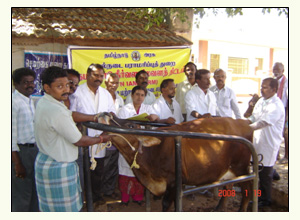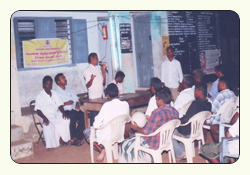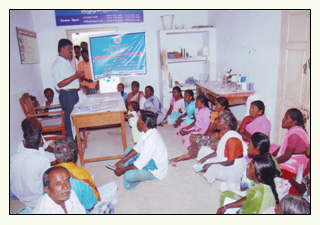Our State being an agricultural based economy with more than 60% of the people engaged in animal husbandry, agriculture and allied activities, it forms the backbone of the rural economy. Animal husbandry contributes significantly in supplementing the income of small, marginal farmers and landless labourers many of whom are women who play a major role in the care and management of livestock. Livestock is not only an important source of income to the rural poor but also helps them sustain their livelihood in times of drought and famine. Livestock provide a diverse range of output varying from draught power and organic manure for agriculture, self employment throughout the year especially for women as well as direct production of milk, meat and eggs for human foodconsumption as preferred items of food.
The contribution of livestock sector to the food basket in the form of milk, eggs and meat to the State has been impressive in fulfilling the animal protein requirement of ever growing human population. The estimated milk production which was 37.91 lakh MT tones during 1995-96 has increased to 54.74 lakh MTtones during 2005-06 which is an increase of 44 percent over 1995-96. Similarly the egg production during the same period has increased from 3,048 million numbers to 6,223 million numbers. Egg production showed an increase of 104 percent during 2005-06 over the base year figure of 1995-96. During the same period, the per capita availability of milk per day went up from 185 gms to 234 grms and eggs per annum from 54 numbers to 97 numbers respectively. The average growth rate of milk and egg during the last decade is 4.4% and 10.4% respectively. According to advance estimates (provisional), the contribution of livestock sector to the Gross State Domestic Product (GSDP) has increased from Rs.523.60 crores during 2004-05 to Rs.548.73 crores during 2005-06, an increase of 4.8%.
Year |
Current Prices (In crores)
|
Constant Prices (In crores)
|
Gross State Domestic Product |
GSDP for Agriculture & Allied Activities |
GSDP for Livestock Sector |
%age Share of Agriculture & Allied Activities to GSDP |
%age Share of Livestock Sector to GSDP |
%age Share of Livestock Sector to Agriculture |
Gross State Domestic Product |
GSDP for Agriculture & Allied Activities |
GSDP for Livestock Sector |
%age Share of Agriculture & Allied Activities to GSDP |
%age Share of Livestock Sector to GSDP |
%age Share of Livestock Sector to Agriculture |
2000-01 |
14109.98 |
2042.56 |
450.19 |
14.48 |
3.19 |
22.04 |
9101.07 |
1457.73 |
295.11 |
16.02 |
3.24 |
20.24 |
2001-02 |
14355.54 |
2056.09 |
525.58 |
14.32 |
3.66 |
25.56 |
8901.06 |
1457.22 |
331.98 |
16.37 |
3.73 |
22.78 |
2002-03 |
15509.93 |
1646.51 |
441.10 |
10.62 |
2.84 |
26.79 |
9170.32 |
1111.75 |
301.05 |
12.12 |
3.28 |
27.08 |
2003-04 |
16845.72 |
1700.21 |
462.71 |
10.09 |
2.75 |
27.21 |
9495.10 |
1081.96 |
308.27 |
11.39 |
3.25 |
28.49 |
2004-05 |
18892.11 |
2025.73 |
523.60 |
10.72 |
2.77 |
25.85 |
10324.84 |
1252.74 |
313.16 |
12.13 |
3.03 |
25.00 |
2005-06 |
20750.28 |
2097.25 |
548.73 |
10.11 |
2.64 |
26.16 |
11198.15 |
1305.98 |
347.43 |
11.66 |
3.10 |
26.60 |
 |
Animal husbandry having a high potential for growth, its hidden potential needs to be explored as this can provide the much needed gainful employment opportunities to the weaker sections of the society and can contribute significantly in regeneration of the rural economy. Animal husbandry can ensure a better quality of life for the rural farmer by not only providing sustainable employment at their location itself but can also act as assets or rural currencies. Animal husbandry thus can act as a powerful instrument for the comprehensive socio-economic transformation of the rural people and can act as an engine for growth and trigger the economy by its multiplying effects.
PRESENT STATUS
TamilNadu is home to 91.41 lakhs head of cattle, 16.58 lakhs buffaloes, 55.93 lakhs sheep, 81.77 lakhs goats besides 3.21 lakhs pigs and 865.91 lakhs poultry as per the 17th livestock and poultry census. The livestock ownership is more evenly distributed among landless labourers, small and marginal farmers and livestock production systems are based on low cost agro-by-products as nutritional inputs.
Veterinary assistance, health cover and breeding support to the livestock and poultry in the State is provided by 1,374 Government graduate veterinary institutions. The National Commission on Agriculture has suggested one veterinarian for every 5000 cattle units by the year 2000 A.D. whereas the present scenario is one veterinarian for every 10,000 cattle units. In addition 1,829 subcentres provide first aid and breeding support. Feed and fodder are the major limiting factors in enhancing farm animal productivity. But in the State a huge gap of around 42% exists between the requirement and availability of green fodder. Though farmers are well aware of the artificial insemination programme, their awareness level on best and latest animal husbandry practices, know-how on emerging new diseases and their control are not up to the excepted level. More over with changing global scenario, the knowledge level of the veterinarians and para-veterinarians needs to be updated frequently to take the technology instantaneously to the end users- the farmers.
Though the State is endowed with large livestock population, the breedable age females covered through artificial insemination is only 30-35%. The conception rate under field conditions ranges from 35-40%. This is due to a mixture of various factors like low nutritional status, improper time of insemination and stress due to walking the animals for long distances to the institutions for artificial insemination, shortage of feed and fodder, prevalence of endemic livestock diseases. In the State, the per day average productivity of a non-descript and crossbred cattle is 2.73 kgs.. and 6.27 kgs. respectively and that of a buffalo is 4.16 kgs. which is much below the expected yield. The productivity can be enhanced by adopting good management practices, feeding practices, bio security measures, effective disease prevention measures, etc.
Animal Husbandry Department is one of the line departments involved in the implementation of World Bank assisted TNIAMWARM project. This project is to be implemented in the State from 2007 to 2013 for a period of 6 years. The main aim of the project is to improve the productivity per unit of water in agriculture and allied activities to enhance the farm income. The World Bank allotted Rs.39.38 crores to Animal Husbandry Department for implementing various schemes in 63 sub basins during the project period.
The objectives of the Animal Husbandry Department in the project are:
- To improve the production potentialities of livestock in the sub-basin.
- To provide veterinary services and breeding support at the farmer’s door steps or nearest to the farmers.
- To ensure total health cover both preventive and curative.
- To improve the conception and calving rate in bovines.
- To reduce the gap between the requirement and availability of green fodder.
- To improve the knowledge level of the farmers on best animal husbandry practices / techniques.
The following components are taken up to improve the production potentialities of livestock sector:
1. Establishment of Cluster Sub basin Veterinary Unit:
Animal Husbandry Department provides  veterinary service and breeding support to the livestock reared by farmers through veterinary institutions/ subcenters. Due to the geographical terrain and distance, some villages are still not covered. Under the IAMWARM Project such unserviced or poorly serviced areas/ villages having a female breedable population of around 2,000 are identified. The areas are covered by establishing Cluster Sub basin Veterinary Units utlisiing the services of unemployed veterinary graduates by Public-Private partnership. The above activity was started during the first year of the project. Mobile routes are formed based on the needs of the farmers and veterinary services and breeding support are provided at the farmer’s door step or nearest to the farmers. veterinary service and breeding support to the livestock reared by farmers through veterinary institutions/ subcenters. Due to the geographical terrain and distance, some villages are still not covered. Under the IAMWARM Project such unserviced or poorly serviced areas/ villages having a female breedable population of around 2,000 are identified. The areas are covered by establishing Cluster Sub basin Veterinary Units utlisiing the services of unemployed veterinary graduates by Public-Private partnership. The above activity was started during the first year of the project. Mobile routes are formed based on the needs of the farmers and veterinary services and breeding support are provided at the farmer’s door step or nearest to the farmers.
The quality in diagnostic services is being strengthened by providing mouth gag, dentist autoclave and mastitis detector to all the 20 diagnostic cebtres across the State. In addition 5 diagnostic centres are to be provided with semi-auto analyzer for complete blood analysis. The centres will act as referral institution for the sub basin. For strengthening the storage facilities for breeding in the sub basins a set of Jumbo Liquid Nitrogen (LN2) container (55 lts) were procured in this project. The Liquid Nitrogen (LN2) required for storage and transport of frozen semen straws for the component was also included.
2. Fodder Cultivation:
Feed and fodder are the major limiting factors in enhancing farm animal productivity. In the State, a huge gap of about 42% exists between requirement and availability of green fodder. The conception rate under field conditions ranges from 35 – 40%. This is due to various factors, among them one is the nutritional status i.e. shortage of feed and fodder is the important one. Green fodder should be fed to the milch animals through out the year, not only to maintain milk production but also for improving the conception rate. Adequate availability of green fodder will also reduce the dependence on concentrates.
To reduce the shortage of green fodder, farmers interested in fodder cultivation are identified and provided with fodder inputs like Co3 slips and Kolukkottai, sorgum fodder seeds free of cost. The selection of fodder is based on the farmers need, soil type and availability of water.
3. Infertility-cum-total-Veterinary Health Care Camps:
 Infertility is one of the problems affecting the conception rate in cattle, causing economic loss to the farmers. To overcome this problem, Infertility-cum-total-Veterinary Health Care Camps are conducted in this project. Infertility is one of the problems affecting the conception rate in cattle, causing economic loss to the farmers. To overcome this problem, Infertility-cum-total-Veterinary Health Care Camps are conducted in this project.  Under this programme, the animals having Infertility problems are identified atthe village level and special camps are arranged with wide publicity. Apart from this, various other activities like health care, disease preventive measures like vaccination against endemic diseases, deworming, castration, artificial inseminatios and pregnancy verification are carried out free of cost. Calf rally are also organised and best calf / calves are given prizes as a motivation for other farmers. During these camps, IEC materials like pamphlets, leaflets on best animal husbandry practices, emerging diseases and their control and optimum utilisation of fodder are distributed to create awareness. Under this programme, the animals having Infertility problems are identified atthe village level and special camps are arranged with wide publicity. Apart from this, various other activities like health care, disease preventive measures like vaccination against endemic diseases, deworming, castration, artificial inseminatios and pregnancy verification are carried out free of cost. Calf rally are also organised and best calf / calves are given prizes as a motivation for other farmers. During these camps, IEC materials like pamphlets, leaflets on best animal husbandry practices, emerging diseases and their control and optimum utilisation of fodder are distributed to create awareness.
4. IEC:
The success of the project depends on effective dissemination  of information to the field in improving the knowledge level of farmers on best and latest animal husbandry practices, emerging new diseases and their control by various outreach programmes. of information to the field in improving the knowledge level of farmers on best and latest animal husbandry practices, emerging new diseases and their control by various outreach programmes.
To improve the know-how level of farmers on best animal husbandry practices / techniques various information, education, communication and training programmes are conducted. Printing of pamphlets on best practices in animal husbandry, biosecurity measures to prevent diseases etc. are printed in Tamil and distributed in the camps and night meetings. Posters and hoardings carrying the activities undertaken in the project are displayed. Farmers' night meetings are conducted to enlighten the practices of best and latest animal husbandry practices among the farmers.
5. Farmers Training:
 Training plays a key role in developing and updating the knowledge and skills of the farmers. Elite farmers interested in animal husbandry activities are selected and three days training are given to them on best practices in animal husbandry, diseases and their prevention, feeding of unconventional feeds etc., by veterinarians in the Government Institutions. Training plays a key role in developing and updating the knowledge and skills of the farmers. Elite farmers interested in animal husbandry activities are selected and three days training are given to them on best practices in animal husbandry, diseases and their prevention, feeding of unconventional feeds etc., by veterinarians in the Government Institutions.
|
|



